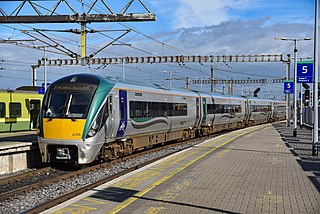
A railcar is a self-propelled railway vehicle designed to transport passengers. The term "railcar" is usually used in reference to a train consisting of a single coach, with a driver's cab at one or both ends. Some railway companies, such as the Great Western, termed such vehicles "railmotors".
The London, Midland and Scottish Railway (LMS) inherited several styles of coaching stock from its constituents. Stock built by the LMS itself can be categorised into three separate periods, numbered I to III.
The London, Midland and Scottish Railway had the largest stock of steam locomotives of any of the 'Big Four' Grouping, i.e. pre-Nationalisation railway companies in the UK. Despite early troubles arising from factions within the new company, the LMS went on to build some very successful designs; many lasted until the end of steam traction on British Railways in 1968. For an explanation of numbering and classification, see British Rail locomotive and multiple unit numbering and classification.
David Jenkinson was a railway modeller and historian, who had a particular interest in the London, Midland and Scottish Railway (LMS) and was president of the LMS Society.
Robert John "Bob" Essery was a British railway modeller and historian with a particular interest in the London Midland and Scottish Railway (LMS) and one of its principal constituents, the Midland Railway (MR).

The British Rail Class 114 diesel multiple units were built by BR Derby from September 1956 to July 1957. Forty-nine 2-car units were built, numbered E50001-49 for driving motors and E56001-49 for driving trailers. The units were used in the early days out of 40A Lincoln TMD (LN) on services all over the county, although a small number were transferred to 41A Sheffield (Darnall) during 1959/60.

The M-10000 was an early American streamlined passenger trainset that operated for the Union Pacific Railroad from 1934 until 1941. It was the first streamlined passenger train to be delivered in the United States, and the second to enter regular service after the Pioneer Zephyr of the Chicago, Burlington and Quincy Railroad.

Sentinel Waggon Works Ltd was a British company based in Shrewsbury, Shropshire that made steam-powered lorries, railway locomotives, and later, diesel engined lorries, buses and locomotives.

The British Rail Class 506 was a 3 carriage electric multiple unit (EMU) built for local services between Manchester, Glossop and Hadfield on the Woodhead Line, which was electrified in 1954 on the 1,500 V DC overhead system.

The Great Northern Railway of Ireland (GNRI) AEC Class were Associated Equipment Company (AEC)–engined diesel multiple units that operated InterCity and suburban services on the GNRI and later Ulster Transport Authority (UTA) systems between 1950 and 1975. They were finally withdrawn in 1972. They were the inspiration for the CIÉ 2600 Class.

The DRG Class SVT 877Hamburg Flyer – sometimes also Flying Hamburger or in German Fliegender Hamburger – was Germany's first fast diesel train, and is credited with establishing the fastest regular railway connection in the world in its time. Correctly named the Baureihe SVT 877, the diesel-electric powered train was used to carry passengers on the Berlin–Hamburg line. It entered service in 1933.
Railmotor is a term used in the United Kingdom and elsewhere for a railway lightweight railcar, usually consisting of a railway carriage with a steam traction unit, or a diesel or petrol engine, integrated into it.

The 22000 Class "InterCity Railcar" is a diesel multiple unit in service with Iarnród Éireann in Ireland.

The 1903 Petrol Electric Autocars were built by the North Eastern Railway in 1903 at their carriage works in York. These were powered by petrol engines which generated electricity for two traction motors which were mounted on the bogie underneath. This means of powering a railway vehicle was pioneering and would eventually be developed into the diesel-electric technology that powered and powers many locomotives worldwide. The railcars were numbered 3170 and 3171 and were 53.5 feet (16.3 m) long and weighed around 35 long tons (36 t). The engine was mounted in an engine compartment 13.25 feet (4.04 m) long. The rest of the vehicles' length was taken up by a vestibule, driving compartment and a 52-seat passenger compartment.
GO Transit, the interregional public transit system in Southern Ontario, has a number of various road and rail vehicles. This includes 90 locomotives, 979 train coaches, and 752 buses.

The Córas Iompair Éireann (CIÉ) 2600 Class were Associated Equipment Company (AEC)–engined diesel multiple units that operated InterCity and suburban services on the CIÉ system between 1952 and 1975. Many were later converted for push–pull operation with diesel locomotives, finally being withdrawn when displaced by the electric Dublin Area Rapid Transit service in the mid-1980s.

A gangway connection is a flexible connector fitted to the end of a railway coach, enabling passengers to move from one coach to another without danger of falling from the train.

Diesel multiple units and railcars are trains, usually with passenger accommodation, that do not require a locomotive. Railcars can be single cars, while in multiple units cars are marshalled together with a driving position either end. As of December 2010, 23 percent of the rail passenger cars used on Network Rail are part of a diesel multiple unit.

A steam railcar is a rail vehicle that does not require a locomotive as it contains its own steam engine. The first steam railcar was an experimental unit designed and built in 1847 by James Samuel and William Bridges Adams. In 1848, they made the Fairfield steam carriage that they sold to the Bristol and Exeter Railway, who used it for two years on a branch line.

A steam railcar, steam motor car (US), or Railmotor (UK) is a railcar that is self powered by a steam engine. The first steam railcar was an experimental unit designed and built in 1847 by James Samuel and William Bridges Adams in Britain. In 1848 they made the Fairfield steam carriage that they sold to the Bristol & Exeter Railway, who used it for two years on a branch line.














